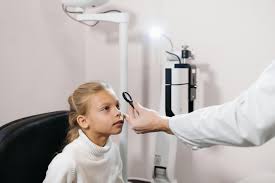Comprehensive eye exams assess eye health beyond visual clarity. They utilize advanced imaging techniques to diagnose conditions such as glaucoma, diabetic retinopathy, and retinal disorders. Many of these conditions develop silently without noticeable symptoms. Here are a few reasons why regular eye exams are beneficial for early detection:
Process of Eye Exams
A comprehensive eye exam evaluates far more than visual clarity alone. Modern exams include multiple tests to assess different aspects of eye health and vision. These evaluations help identify issues that may not present noticeable symptoms.
Visual acuity testing measures how clearly you see at various distances. You read letters and numbers of different sizes, first with your natural vision and then with lenses to determine the precise prescription needed. Retinoscopy further refines this by having you focus on a specific letter while the doctor cycles through lenses to identify the most effective correction.
Additional tests examine the internal and external structures of the eye. A slit lamp allows detailed inspection of the cornea, iris, and lens to detect potential issues. Optical coherence tomography captures high-resolution images of the retina and back-of-eye structures, enabling the detection of early signs of conditions such as diabetic retinopathy or macular degeneration.
Technology Makes Detection
Modern eye care technology allows doctors to detect eye conditions at their earliest stages. ZEISS imaging systems provide detailed analysis of vision and eye structures, revealing even the most subtle changes. Optical coherence tomography produces cross-sectional images of the retina, showing tissue layers and potential damage that exams might miss. Retinal imaging captures wide-field photographs of the back of the eye, creating a baseline for future comparisons and enabling the detection of changes over time.
Eye Exam Candidates
Eye care needs change throughout life, requiring tailored approaches for each stage. Early detection and routine monitoring help maintain vision and support overall eye health. Regular check-ups provide the foundation for identifying potential issues and determining the best course of care. Individuals with higher risk factors may require more frequent evaluations to protect long-term vision.
- Pediatric exams focus on proper visual development and learning-related vision needs.
- Annual adult exams help monitor conditions such as glaucoma and diabetic retinopathy.
- Senior exams (65+) target age-related issues such as cataracts, macular degeneration, and glaucoma.
- Patients with diabetes, high blood pressure, or a family history of eye disease may need more frequent exams.
Common Conditions Detected
Glaucoma gradually damages the optic nerve, often beginning with unnoticed loss of peripheral vision. Diabetic retinopathy affects the retina’s blood vessels and can progress without symptoms. Cataracts cloud the eye’s natural lens, and macular degeneration affects central vision, which is used for activities such as reading, driving, and recognizing faces. Regular exams can detect these conditions early and support timely care.
Start Your Eye Health Plan
Regular eye exams support long-term vision health and allow early detection of potential problems. Most adults benefit from annual visits; however, those with risk factors may require more frequent monitoring. Keeping track of your family’s eye health history and noting any sudden changes in your vision can provide valuable information for your doctor. Schedule a comprehensive eye exam to assess your vision and discuss a personalized plan for ongoing eye care.

